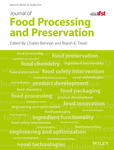Physical and chemical properties, antioxidant capacity, and total phenolic content of xyloglucan component in tamarind (Tamarindus indica) seed extracted using subcritical water
Abstract
Tamarind kernel powder was utilized as raw material for xyloglucan component extraction. The main aims were to determine the potential of applying subcritical water in xyloglucan component extraction and to investigate effects on yield and properties of extracted xyloglucan components. Ratio of tamarind kernel powder to water for all extractions was 1:20 (w/v) with extraction temperatures of 100–200°C. Extracted xyloglucan component samples were determined for their color, pasting property, viscosity, water absorption index (WAI), water solubility index (WSI), molecular weight, antioxidant capacity, and total phenolic content. It appeared that xyloglucan components extracted by subcritical water, especially in cases where severe conditions were applied, had greater color intensity and WSI than conventional method but less holding strength, setback from trough, final viscosity, WAI, antioxidant capacity, and total phenolic content. Subcritical water extraction at 175°C provided the highest production yield of 62.28% which was remarkably higher than conventional method.
Practical applications
Tamarind seed, an economic by-product from the commercial utilization of tamarind fruit and pulp, contains a high proportion of xyloglucan. Xyloglucan in tamarind seeds is deemed as a natural, non-toxic, and edible polysaccharide. Currently, it is utilized in food industry as a gelling agent due to its gel forming capability over a wide pH range and heat stability. This study demonstrated that the subcritical water extraction technique was an effective method for tamarind seed xyloglucan extraction because it provided apparently higher extraction yield than conventional extraction method. The xyloglucan component powder manufactured in this work can be used as a food additive; however, suitable applications for the xyloglucan component extracted using the subcritical water extraction technique must be considered based on its physical, chemical, and functional properties.
CONFLICT OF INTEREST
The authors have declared no conflicts of interest for this article.




